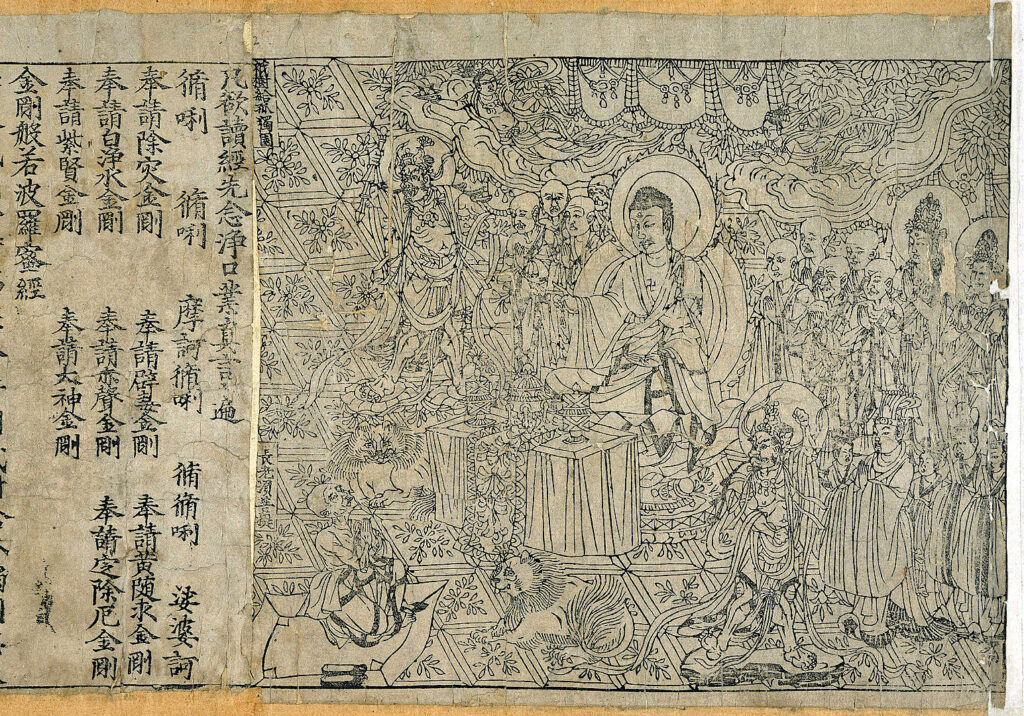
It isn’t easy to say which book is the oldest in the world, because the answer depends on what, exactly qualifies as a book. Dating from the year 868, the Chinese Diamond Sūtra is known as “the world’s earliest dated, printed book,” the words used on the web site of the British Library, which owns the thing itself. It was found in northwest China, “in a holy site called the Mogao (or ‘Peerless’) Caves or the ‘Caves of a Thousand Buddhas,’ which was a major Buddhist centre from the 4th to 14th centuries,” its page explains. “In 1900, a monk named Wang Yuanlu discovered the sealed entrance to a hidden cave, where tens of thousands of manuscripts, paintings and other artifacts had been deposited and sealed up sometime around the beginning of the 11th century.”

Included in this treasure trove, this copy of the Diamond Sutra “was brought to England by the explorer Sir Aurel Stein in 1907.” With the form of not a-book-as-we-know-it but “seven strips of yellow-stained paper printed from carved wooden blocks and pasted together to form a scroll 16 feet by 10. 5 inches wide,” as Jeremy Norman writes at Historyofinformation.com, it may not seem all that impressive when seen from a distance.
But “its text, printed in Chinese, is one of the most important sacred works of the Buddhist faith,” a dialogue between the Buddha and one of his pupils on the “perfection of insight” and the nature of reality itself, titled for its potential to cut like a diamond blade through the layers of illusion in which we live.
Today, we need not examine the Chinese Diamond Sutra only at a distance, for the British Library has made a complete digitization of the scroll available on its “Virtual Books” page. For those who don’t read ninth-century Chinese, the most interesting element will be the frontispiece, which, as Norman writes, “shows the Buddha expounding the sutra to an elderly disciple called Subhuti. That is the earliest dated book illustration, and the earliest dated woodcut print.” The British Library notes that “the finesse in the details evidences the fact that printing had already grown into a mature technology by the ninth century in China,” long before such other famous books as Shakespeare’s First Folio or even the Gutenberg Bible. This is an artifact of great historical value, reflected by the degree of care with which it’s been conserved. But as a believer might add, why focus on the age of a book when the wisdom it offers is timeless?
Related content:
Europe’s Oldest Intact Book Was Preserved and Found in the Coffin of a Saint
The Medieval Masterpiece The Book of Kells Has Been Digitized and Put Online
Oxford University Presents the 550-Year-Old Gutenberg Bible in Spectacular, High-Res Detail
Behold a Digitization of “The Most Beautiful of All Printed Books,” The Kelmscott Chaucer
One of World’s Oldest Books Printed in Multi-Color Now Opened & Digitized for the First Time
Based in Seoul, Colin Marshall writes and broadcasts on cities, language, and culture. His projects include the Substack newsletter Books on Cities, the book The Stateless City: a Walk through 21st-Century Los Angeles and the video series The City in Cinema. Follow him on Twitter at @colinmarshall or on Facebook.
